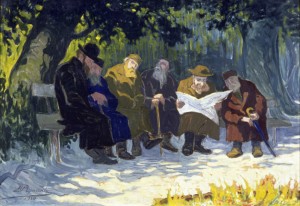Jewish artist’s great-granddaughter casts herself in ‘21st century detective story’
By Casey Logan / Omaha World-Herald staff writer, Tuesday March 18, 2014
Above: A painting by Moshe Rynecki, a Polish-Jewish artist who died in the Holocaust. His great-granddaughter is working to catalog his art.
Elizabeth Rynecki had just finished giving a talk on the subject of her personal obsession, when a fateful hand rose at the back of the room.
For the past 15 years, Rynecki has been on a mission to locate and catalog the lost paintings of her great-grandfather, Moshe Rynecki, a Polish-Jewish artist who died in the Holocaust. That search has connected her with individuals and institutions around the world, unearthing information in unexpected places about her great-grandfather’s life and art. As with any good investigation, one connection inevitably led to another, which is how Rynecki found herself in front of an audience last fall at the University of Toronto.
Moments before the lecture let out, a man in the back of the room stood up. What he said next so shook Rynecki that she immediately followed him into the university’s archives, where he presented the contents of a suitcase that had escaped Nazi Germany and spent the next 60 years crossing the globe for what suddenly seemed like the express purpose of landing in front of her incredulous eyes.
Rynecki will talk about that discovery, and the story of her ongoing search, during a free lecture tonight at Kaneko. She’ll also discuss the subject of art restitution and the “complicated topic” of why she’s acting as a historian — she hopes to complete a documentary about her efforts — rather than as a claimant seeking to repossess her great-grandfather’s work.
Her story begins in the 1920s and 1930s, when Moshe Rynecki documented scenes of Jewish life in Warsaw, Poland. He had amassed more than 800 paintings by the time the Nazis invaded Poland in 1939. Fearing their destruction, Moshe bundled his work into a number of small collections and hid them with gentile acquaintances in and around the city.
His fears came true. In the years after the war, his family recovered only about 120 paintings. For decades, the majority were thought to be lost or destroyed. Those that remained hung on the walls of family members. Elizabeth Rynecki recalls growing up around them, though she wasn’t always interested in finding out what happened to the rest.
That changed after the 1992 death of her grandfather George, Moshe’s son, who left behind a legacy item of his own: a memoir about surviving the Holocaust and an ode to the father who didn’t.
“There are hundreds of books on the subject,” George wrote. “Nevertheless, I am a Jew and I write. I’ll do it till the end of my days. If only for my granddaughter, Elizabeth, to know the truth, and not to be afraid of it.”
Rynecki took the message and made it her mission. In 1999, with help from her father, she created a website devoted to the art work of Moshe Rynecki. Initially, she saw the site as a way to share what remained of her great-grandfather’s art and a possible resource for teachers to use when discussing the Holocaust or Jewish life in eastern Europe before World War II.
But then she started to hear from people around the world. A museum curator from the Yad Vashem memorial in Israel paid a visit to California and left with a painting now on permanent display. Others contacted her about paintings in their possession. A man in Canada said his family once had as many as 50 of Moshe’s paintings. Someone in New York said he had six. Another man in Los Angeles had two. Rynecki came to learn the Jewish Historical Institute in Warsaw also held paintings by Moshe.
Though exciting, the developments presented challenges. A list of Moshe’s paintings no longer existed. Rynecki knew several hundred paintings could be out in the world, but not what they looked like or what they were called. Shreds of information would appear. A possible painting here, a book referencing another there.
“I think it’s this 21st century detective story, and I’ve crowd-sourced a lot of it,” she said.
To date, she’s accounted for about 80 new paintings. How many are left to be discovered? It’s the question, perhaps without answer, that drives her mission. “I don’t think it will ever end,” she said.
There have been twists and turns, false leads and unbelievable luck. At one point, Rynecki discovered a website selling what she believes to be forgeries, even though her great-grandfather’s paintings don’t sell for considerable amounts.
And then Canada. Rynecki traveled to Toronto last October to meet a man whose parents had rescued a bundle of Moshe’s paintings. Two days later, Rynecki spoke at the university, unaware that a man in the audience had something incredible to share with her.
Not a painting, but the voice of her great-grandfather, written in Polish by his own hand.
The letters carried their own story of survival, packed away in a suitcase full of research materials and carted halfway around the world by a man running from the Nazis. Kept by that man until his death decades later, and then by his wife, who finally gave it residence in the archives of the local university.
“Because they hoped one day someone would come looking,” she said. “And here I am.”
